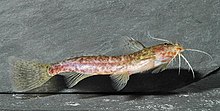Mochokidae
| Mochokidae | ||||||||||||
|---|---|---|---|---|---|---|---|---|---|---|---|---|

|
||||||||||||
| Systematics | ||||||||||||
|
||||||||||||
| Scientific name | ||||||||||||
| Mochokidae | ||||||||||||
| Jordan , 1923 |
The Mochokidae are an exclusively African family of catfish for which there is no general German name. Although they are often referred to as whiskered catfish, this only includes the subfamily Mochokinae . The second subfamily belonging to the Mochokidae, the Chiloglanidinae or African suckling catfish, have no feathered barbels and would therefore be completely wrong with the name Fiederbartwelse. The English name for this family is Squeaker Catfishes , because of the squeaky or squeaky noises they can make. The scientific name Mochokidae is derived from the word 'Mochok', which the author Léon Daniel de Joannis (1803–1868) specifies as the native name for the fish on the Nile.
Mark
All representatives have a strong bony head capsule and a clearly visible shoulder process (humeral process). There are three pairs of barbels (two of them on the lower jaw), which are integrated into the mouth disc of the African suckling catfish (subfamily Chiloglanidinae). In the Fiederbartwelsen (subfamily Mochokinae) the lower jaw barbels are pinnate. The body is scaly and without bone plates. The first ray of the dorsal fin is strong, thorn-like and mostly serrate. The adipose fin is usually relatively large and, with a few exceptions, has no fin rays. The pectoral fins also have a strong, thorn-like and serrated hard ray as the first fin ray. The caudal fin is designed to be relatively variable, mostly bilobed and more or less deeply split.
The representatives of the subfamily Chiloglanidinae are built relatively flat in order to be optimally adapted to current-rich waters. In contrast, the body shapes of the species of the subfamily Mochokinae are somewhat more variable. There are both higher-backed species, such as Synodontis eupterus , some of which even prefer to swim in the supine position (including the back- swimming Congo cat ), as well as slender species, again adapted to high currents , such as Synodontis brichardi .
Just as slim but rather brook loach-shaped is z. B. Microsynodontis polli , which characterizes it as a species that lives in highly structured habitats. The shape of the mouth is typical of the species and is often an indication of the species belonging to it. The suckling mouths of the Chiloglanidinae also differ from one species to another. In the species of the subfamily Mochokinae, the feathery mandibles catch the eye. In Synodontis membranaceus we find wide membranes in the maxillary barb, which gave the species its name.
Way of life
The Mochokids live in a wide variety of water types, but they are always fresh water. The genera Atopochilus , Chiloglanis and Euchilichthys live in fast flowing waters and, like the South American armor catfish (Loricariidae), have a mouth with which the animals can suck on the ground.

Systematics
- Family Mochokidae Jordan, 1923
- Subfamily Chiloglanidinae Riehl & Baensch, 1990
- Genus Atopochilus Sauvage, 1879
- Genus Atopodontus Friel & Vigliotta, 2008
- Genus Rapids Catfish ( Chiloglanis ) Peters, 1868
- Genus Euchilichthys Boulenger, 1900
- Subfamily Mochokinae Jordan, 1923
- Genus Acanthocleithron Nichols & Griscom , 1917
- Genus Pygmy Catfish ( Microsynodontis ) Boulenger, 1903
- Genus Mochokiella Howes, 1980
- Genus Mochokus Joannis, 1835
- Genus Synodontis Cuvier, 1816
- Subfamily Chiloglanidinae Riehl & Baensch, 1990
literature
- Seegers, L. (2008): The catfish of Africa. A handbook for identification and maintenance. Tetra Verlag, Germany. 604pp.
Individual evidence
- ↑ de Joannis, L. (1835): Observations sur les poissons du Nil, et description de plusieurs espèces nouvelles. Magasin de Zoologie 1835 (5 anneé): 53 pp.
- ↑ Thomas R. Vigliotta: A phylogenetic study of the African catfish family Mochokidae (Osteichthyes, Ostariophysi, Siluriformes), with a key to its genera (PDF; 643 kB). Proceedings of the Academy of Natural Sciences of Philadelphia, 157 (1): 73-136. 2008 doi : 10.1635 / 0097-3157 (2008) 157 [73: APSOTA] 2.0.CO; 2
- ↑ Jordan, DS (1923): A classification of fishes including families and genera as far as known. Stanford University Publications, University Series, Biological Sciences , 3 (2): 77-243 + ix.
- ↑ Riehl, R. & Baensch. H. (1990): Aquarium Atlas Volume 3. Mergus Verlag, Melle. 1104pp.
- ^ Sauvage, HE (1879): Notice sur la faune ichthyologique de l'Ogôoué. Bulletin de la Société philomathique de Paris , (7th Série) 3: 90-103.
- ↑ Friel, JP & TR Vigliotta (2008): Atopodontus adriaensi, a new genus and species of African suckermouth catfish from the Ogooué and Nyanga River systems of Gabon (Siluriformes: Mochokidae). Proceedings of the Academy of Natural Sciences of Philadelphia , 157: 13-23.
- ↑ Peters, W. (CH) (1868): About a new genus of catfish, Chiloglanisdeckii, and some other freshwater fish from East Africa, discovered by Baron Carl von derdecke. Monthly reports of the Academy of Science in Berlin 1868 : 598-602, Pl. 2.
- ^ Boulenger, GA (1900): On some little-known African silurid fishes of the subfamily Doradinae. Annals and Magazine of Natural History , (Series 7) 6 (36): 520-529.
- ↑ Nichols, JT & L. Griscom (1917): Fresh-water fishes of the Congo basin obtained by the American Museum Congo expedition, 1909-1915. Bulletin of the American Museum of Natural History , 37 (25): 653-756, Pls. 64-83.
- ^ Boulenger, GA (1903): On the fishes collected by Mr. GL Bates in southern Cameroon. Proceedings of the General Meetings for Scientific Business of the Zoological Society of London , 1903, 1 (1): 21-29, Pls. 1-5.
- ^ Howes, GJ (1980): A new catfish from Sierra Leone. Bulletin of the British Museum (Natural History) Zoology , 38 (3): 165-170.
- ↑ de Joannis, L. (1835): Observations sur les poissons du Nil, et description de plusieurs espèces nouvelles. Magasin de Zoologie 1835 (5 anneé): 53 pp.
- ^ Cuvier, G. (1816): Le Règne Animal . Edition 1. Les reptiles, les poissons, les mollusques et les annélides. i-xviii + 1-532, [Pls. 9-10, in v. 4].
Web links
- Mochokidae on Fishbase.org (English)



